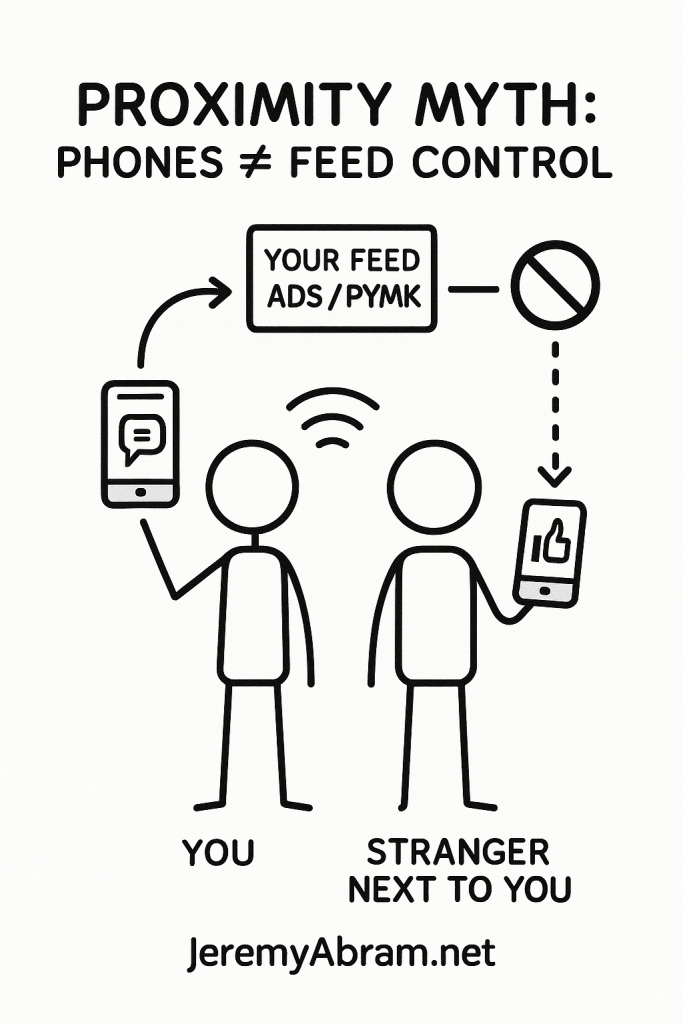
Short answer: No—simply being physically near other devices does not, by itself, make Facebook change what you see. Your ads, feed, and “People You May Know” (PYMK) are shaped by signals tied to your account and devices (your activity, your location settings, your uploaded contacts, your networks, etc.), not by passively “picking up” strangers’ tastes via Bluetooth. Below is a clear, fact-based breakdown—and what you can do to keep things private.
What actually does influence your Facebook content
1) Your activity on and off Facebook
- On-Facebook activity (pages you follow, posts you engage with, groups, etc.) and advertiser inputs determine why you see particular ads; Meta has long explained this via the “Why am I seeing this ad?” transparency feature. Facebook About+1
- Off-Facebook activity from websites/apps that use Meta tools (Pixel, SDK, Conversions API) can also inform ads; Meta introduced an Off-Facebook Activity control to review/clear this data. Facebook About
2) Location (places—not people)
- Advertisers can target by geographic location (live in, recently in, or traveling in a chosen area). That’s about where you are, not who’s standing near you. Facebook
- Meta says it may receive precise location via GPS, Wi-Fi and Bluetooth when you allow it, and can also estimate location from your network (IP). This powers things like local relevance and geo-targeted ads. Facebook
3) Your contacts and social graph (PYMK)
- Facebook has repeatedly stated PYMK is based on factors like mutual friends, shared schools/workplaces, networks, groups, and uploaded contacts—the classic ways it infers who you might know. The Guardian
Important: Proximity features were pared back, not expanded. Facebook’s Nearby Friends and related background location history features were discontinued in 2022. 9to5Mac+1
Common myths vs. the evidence
Myth 1: “Facebook listens to my mic when I’m talking.”
Meta (and Instagram’s leadership) has repeatedly denied using microphones to target ads or change News Feed; these denials have been consistent for years. TIME+2Vox+2
Myth 2: “Standing near someone makes their interests rub off on my ads.”
- What’s true: Ads often reflect shared context: you visited the same store/site, you’re in the same city radius target, or a brand uploaded your email in a customer list. These are account- or place-level signals, not “who’s in the room.” Facebook+1
- What’s not shown: There’s no public evidence Meta blends other people’s preferences into your ad profile merely because those people are nearby.
Myth 3: “PYMK uses literal device-to-device sensing.”
- Reality: Facebook holds a patent about using wireless signals to infer real-world encounters, which sparked headlines. But a patent ≠ product behavior; the company’s public explanations for PYMK emphasize mutual friends, groups, schools/work, and contacts—not Bluetooth proximity. WIRED+1
What can create “creepy coincidence” moments?
- Shared devices/accounts: If someone else uses your phone or a shared TV/app while signed in to your account, their activity trains your feed and ads. (This is the most common culprit in households.) Facebook About
- Same places, same time: Entering a store that runs local ads, or being inside an advertiser’s geofence, can trigger relevant ads for you (and others there), which feels like “it heard me,” but it’s just location targeting. Facebook
- Off-Facebook data flows: Visiting the same websites/apps as a friend can independently feed both of your Meta ad profiles via pixels/SDKs. Facebook About
Friend suggestions (PYMK): the boring (and accurate) explanation
- Mutual connections: Shared friends, groups, workplaces, or schools are strong PYMK signals. The Guardian
- Contacts you or others uploaded: If your email/number appears in others’ address books that were uploaded, you may be suggested to each other—this also covers people who aren’t on Facebook via “contact uploading & non-users” handling. Facebook
- What you won’t find documented: Facebook saying it uses passive proximity (e.g., “our phones were near each other on a bus”) as a PYMK input.
Newer wrinkle to know about (not proximity-related)
In 2025 Meta announced it will start using conversations with its AI assistant to help personalize ads and content (with carve-outs for sensitive topics and with regional exceptions). That’s about what you ask an AI, not nearby devices. The Verge+1
Practical steps to keep your feed and ads “yours”
- Audit location permissions
Decide whether Facebook can access precise location (GPS/Bluetooth/Wi-Fi). If you turn it off, Facebook may still estimate location via IP, but geo-targeting becomes broader. Facebook - Use “Why am I seeing this ad?”
Tap the menu on an ad to see the exact reasons (e.g., “you’re in X location,” “you’re in the advertiser’s customer list,” or interest categories) and adjust preferences. Facebook About+1 - Review Off-Facebook Activity
View/clear the data Meta receives from sites/apps and optionally “disconnect” future activity from your account. Facebook About - Manage contact uploading
If you don’t want your address book feeding PYMK, disable Contacts Uploading in Accounts Center (and delete previously uploaded contacts). Facebook - Separate accounts and devices
Avoid letting others use Facebook while signed in as you (phones, tablets, smart TVs). Shared usage will absolutely skew your feed. Facebook About - Know what’s gone
Don’t rely on (or fear) Nearby Friends—it was discontinued, along with related background location features. 9to5Mac
Bottom line
- Ads: Determined by your activity (on/off Facebook) and where you are—not by the random people around you. Location can matter, proximity to devices does not. Facebook+1
- Friend suggestions (PYMK): Driven by mutual friends, shared affiliations, and uploaded contacts—not passive phone-to-phone detection. The Guardian
- Microphone eavesdropping: Meta says no, and has said so for years. Perception of “it must have listened” is usually explained by location/targeting and off-site data flows. TIME+1
Leave a Reply